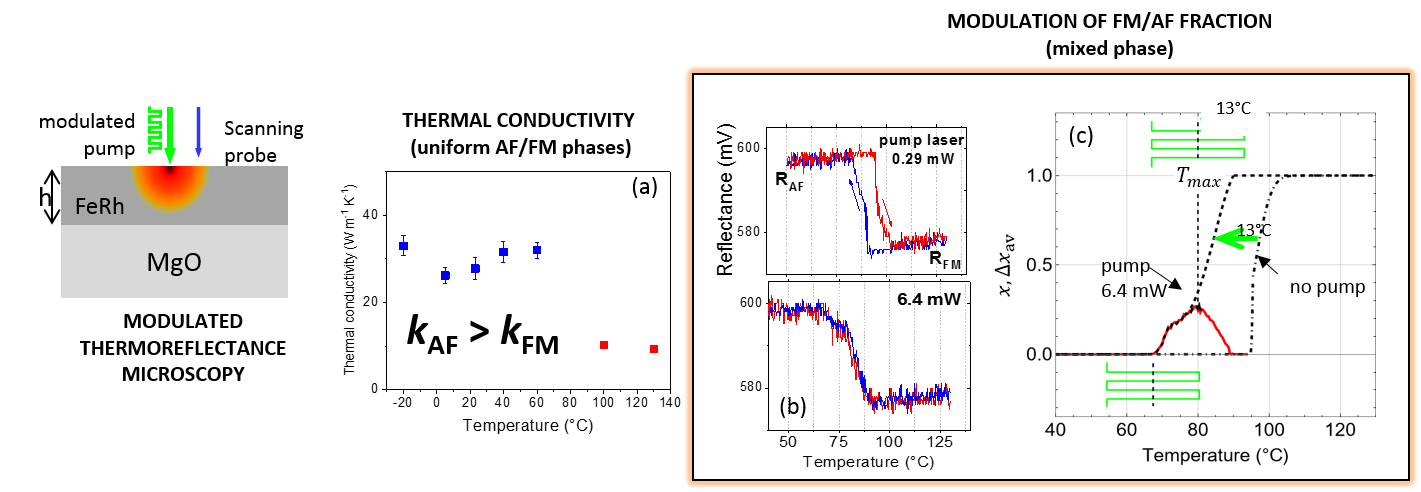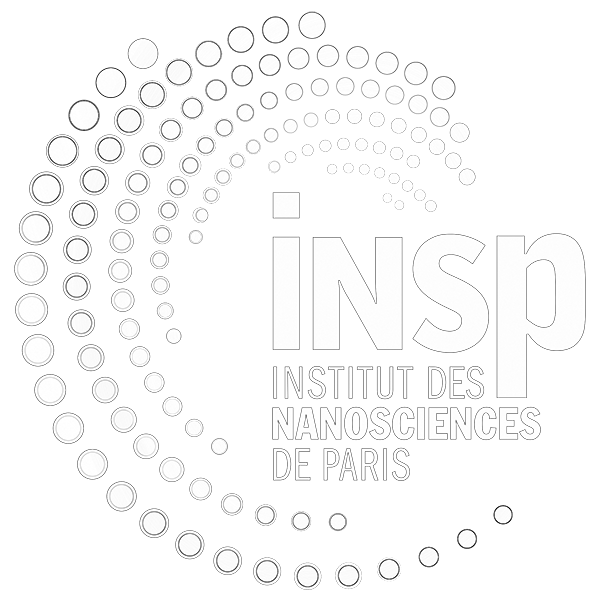Liste des membres
Equipements
Stages et Emplois
Thèses
Publications
Actualités
Team
- Permanent staff : Catherine Gourdon, Laura Thevenard
- PhD Student: A. Vythelingum (2021-2024)
- Post-doctorant: Djoudi Ourdani (2023-2025)
FeRh is an intriguing material that exhibits a first-order phase transition, changing from an antiferromagnetic (AF) to a ferromagnetic (FM) state when heated. The temperature at which this transition occurs is highly sensitive to the Fe and Rh stoichiometry, the material’s deformation state, and the applied magnetic field. This unique property makes FeRh a promising candidate for thermally assisted magnetic recording applications. Additionally, it has been demonstrated that the AF-FM transition can be initiated by ultrafast laser pulses, which induce a heating effect, highlighting its potential for use in optical information storage. In the framework of the ANR ACAF we have studied different facets of this material:
- Magneto-acoustic coupling in FeRh: see dedicated “magneto-acoustics” page
- Graded composition growth of FeRh [PRB25]: we implemented on the INSP sputter machine a technique previously developed by L. Ranno et al which allows us to obtain at each run the precise Fe/Rh stoechiometry required for the presence of an antiferromagnetic-ferromagnetic transition.
- Explanation of the origins of low field microwave absorption [PRB25] : the strong temperature variations of the coercivity of FeRh allowed us to validate a simple model showing that hysteretic features appearing in ferromagnetic resonance experiment come from the hysteresis of the static magnetization orientation. This also allows to explain previously published unexplained data (Fig. 1c).
- Collaboration: I Boventer (LAF, Palaiseau, France)

Fig. 1: (a) Antiferromagnetic to ferromagnetic transition in FeRh. (b) Elastic constants of FeRh [PRB24]. (c) Hysteric ferromagnetic resonance model developed thanks to a study on FeRh [PRB25].
- Experimental determination of the elastic constants (Cij) of FeRh at varying temperatures, in both AF and FM phases (Fig. 1b), using a combination of Brillouin Light Scattering and picosecond acoustics experiment [PRB24]. The Cij extracted from these measurements moreover match quite well those calculated numerically using first-principles anharmonic modeling and machine- learned interatomic potentials. This is an important material parameter to know, e.g. to compute the acoustic wave velocity in heterostructures containing FeRh.
- Collaboration: D.Fournier and B. Perrin (ACOUS team at INSP), samples from J. Arregi and V. Ulkhir (CEITEC, Brno, Czech Republic) V. Laude (FEMTO-ST, Besançon, France), M. Verstraedte and A. Castellano (Nanomat lab, Liège, Belgium).
- Experimental determination of the thermal conductivity of FeRh at varying temperatures, in both AF and FM phases, using modulated thermoreflectance microscopy [PRMat24]. As often occurs upon alloying, and despite the good crystallinity of the layer, κ was found to be lower than the thermal conductivities of its constituting elements. More unexpectedly, given the electrically more conducting nature of the FM phase, it turned out to be three times lower in the FM phase compared to the AFM phase, a feature that could not be reproduced by first- and second-principles simulations.
- Collaboration: D.Fournier and B. Perrin (ACOUS team at INSP), samples from J. Arregi and V. Ulkhir (CEITEC, Brno, Czech Republic), M. Verstraedte and A. Castellano (Nanomat lab, Liège, Belgium).

-
- Fig. 2: Modulated thermoreflectance microscopy set-up. (a) Estimation of the thermal conductivity of FeRh [
- ], (b,c) Under large temperature modulations induced by high laser powers, we show the system essentially travels with return point memory along its quasi-static thermal cycles, inducing a large modulation of the FM fraction, and an apparent closing of the hysteresis cycle [].
-
- Collaboration: D.Fournier and B. Perrin (ACOUS team at INSP), samples from J. Arregi and V. Ulkhir (CEITEC, Brno, Czech Republic), M. Verstraedte and A. Castellano (Nanomat lab, Liège, Belgium).
- Modulation of the ferro/antiferromagnetic fraction of FeRh using laser pulses: using a modulated thermoreflectance microscopy set-up, we show that a 100 kHz laser modulation induces a substantial modulation of the FM fraction (up to 90%) with increasing laser power. A simplified rate-independent hysteresis model showing return-point-memory is then implemented, with the FM fraction at a given point calculated as the sum overan ensemble of bistable hysterons having undergone a temperature excursion corresponding to a given laser power.This offers an insight into the leading role of quenched disorder in defining thermal hysteresis in FeRh under high excitation frequency, when the materialis periodically driven out-of-equilibrium.
- Collaboration: D.Fournier (ACOUS team at INSP), samples from J. Arregi and V. Ulkhir (CEITEC, Brno, Czech Republic), M. LoBue, M. Almanza and A. Pécheux (SATIE, Cachan, France).
Publications
[PRB25] Origin of low-field microwave absorption in metallic magnetic films evidenced in FeRh/Ta/GaAs, Ba, D Nguyen, Olivetti, G, Tremblais, T, Boventer, I, Vidal, F Duvauchelle, J.-E. Gourdon, C, Thevenard, L, Physical Review B 111 014426 (2025) [PRMat24] Magnetic phase dependency of the thermal conductivity of FeRh from thermoreflectance experiments and numerical simulations, Castellano, K. Alhada-Lahbabi, J. A. Arregi, V. Uhlíř, B. Perrin, C. Gourdon, D. Fournier, M. J. Verstraete, and L. Thevenard, Phys. Rev. Materials 8, 084411 (2024) [PRB24] Experimental determination of the temperature- and phase-dependent elastic constants of FeRh Ourdani, A. Castellano, A. K. Vythelingum, J. A. Arregi, V. Uhlíř, B. Perrin, M. Belmeguenai, Y. Roussigné, C. Gourdon, M. J. Verstraedte, and L. Thevenard, Phys. Rev. B 110, 014427 (2024)
